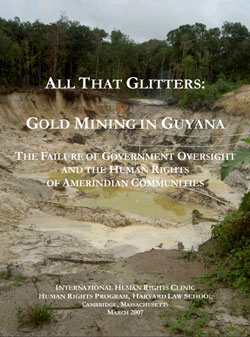Gold mining in Guyana damages environment, threatens Amerindians
Gold mining in Guyana damages environment, threatens Amerindians
mongabay.com
March 7, 2007
Informal gold mining is causing environmental harm and human rights abuses in Guyana says a new report from the International Human Rights Clinic (IHRC) of Harvard Law School’s Human Rights Program.
The report, titled “All that Glitters: Gold Mining in Guyana,” notes that the Guyanese government has failed to reign in wildcat miners and protect the rights of indigenous populations. It also says the mining has caused deforestation and mercury pollution, which can cause severe public health problems, and worsened malaria in the region.
“Medium and small scale gold mining as currently practiced and regulated inflict severe environmental, health, and social damage on the areas and people near mining operations,” said Bonnie Docherty, clinical instructor at the IHRC. “This is a classic case of the link between environmental damage and human rights abuses. By contaminating the country’s rivers, gold mining is threatening the lives and livelihoods of the indigenous people.”

|
The report studies the small and medium scale gold mining on Amerindian indigenous communities and analyzes the regulatory environment in which these abuses occur. It notes that are four flaws in Guyana’s legal system that have exacerbated the ills of gold mining: giving priority to subsurface rights over surface rights; failing to fully implement environmental regulations from 2005; under-enforcement of its current regulations; and weak monitoring of medium and small scale mines, which the report notes “represent the majority of those in Guyana.”
“Our observations confirmed that the areas around mines resemble a moonscape of barren, mounded sand and mud,” Docherty said. “Since small scale miners typically wash the topsoil away in order to get to the gold-bearing clayey soil underneath, the sites of former mines are quite infertile and incapable of supporting regenerated rainforest.”
The report calls upon the Guyanese government to “implement institutional reforms to curb the environmental degradation caused by mining and to protect the rights of the Amerindian community” by limiting locations where mining can take place, implementing mining laws already on the books, promoting education of Amerindians and miners on mining safety, and encouraging cooperation between miners and local communities.
“The most significant changes in mining regulation must come from the Guyanese government,” Docherty told mongabay.com via email.
She adds that the international community can also play a role in addressing the mining problem.
“The biggest role the international community can play is to push Guyana to fulfill its obligations under international law,” she explained. “Specifically, international financial institutions, which are significantly involved in Guyana’s economic development, have a duty to use their influence to promote sustainable practices that protect the rights of Guyana’s most vulnerable inhabitants.”
The report is available in PDF format at All that Glitters: Gold Mining in Guyana
Related articles
Mining in Venezuelan Amazon threatens biodiversity, indigenous groups. Troubles are mounting in one of Earth’s most beautiful landscapes. Deep in the Venezuelan Amazon, among ancient forested tabletop mountains known as tepuis, crystalline rivers, and breathtaking waterfalls, illegal gold miners are threatening one of world’s largest remaining blocks of wilderness, one that is home to indigenous people and strikingly high levels of biological diversity. As the situation worsens — a series of attacks have counted both miners and indigenous people as victims — a leading scientific organization has called for the Venezuelan government to take action.
Illegal mining threatens forest, biodiversity, natives in French Guiana. As Europe frets over climate change and deforestation, threats to “Europe’s largest tropical rainforest” are mounting, according to reports from French Guiana. While French Guiana is best known for its infamous Devil’s Island penal colony and as the main launch site for the European Space Agency, which is responsible for more than 50% of the state’s economy activity, most of the territory is covered with lowland tropical rainforest. French Guiana’s forests are biologically rich with some 1,064 known species of amphibians, birds, mammals and reptiles, and 5,625 species of vascular plants according to figures from the World Conservation Monitoring Center.
Biofuels, logging may spur deforestation in Guyana. Growing timber exports and rising interest in biofuels are raising concerns that deforestation could accelerate in the South American country of Guyana. Guyana is a small, lightly populated country on the north coast of South America. About three-quarters of Guyana is forested, roughly 60 percent of which is classified as primary forest. Guyana’s forests are highly diverse: the country has some 1,263 known species of amphibians, birds, mammals, and reptiles, and 6,409 species of plants. According to an assessment by the ITTO, forests in Guyana can be broken down as follows: mixed forest (36 percent), montane forest (35 percent). swamp and marsh (15 percent), dry evergreen (7 percent), seasonal forest (6 percent), and mangrove forest (1 percent).
Amazon natives use Google Earth, GPS to protect rainforest home. Deep in the most remote jungles of South America, Amazon Indians (Amerindians) are using Google Earth, Global Positioning System (GPS) mapping, and other technologies to protect their fast-dwindling home. Tribes in Suriname, Brazil, and Colombia are combining their traditional knowledge of the rainforest with Western technology to conserve forests and maintain ties to their history and cultural traditions, which include profound knowledge of the forest ecosystem and medicinal plants. Helping them is the Amazon Conservation Team (ACT), a nonprofit organization working with indigenous people to conserve biodiversity, health, and culture in South American rainforests.
This article uses quotes from a Harvard University news release.